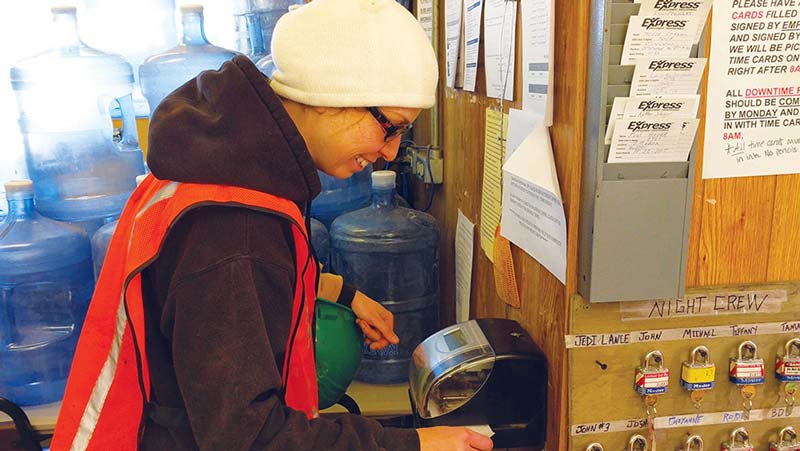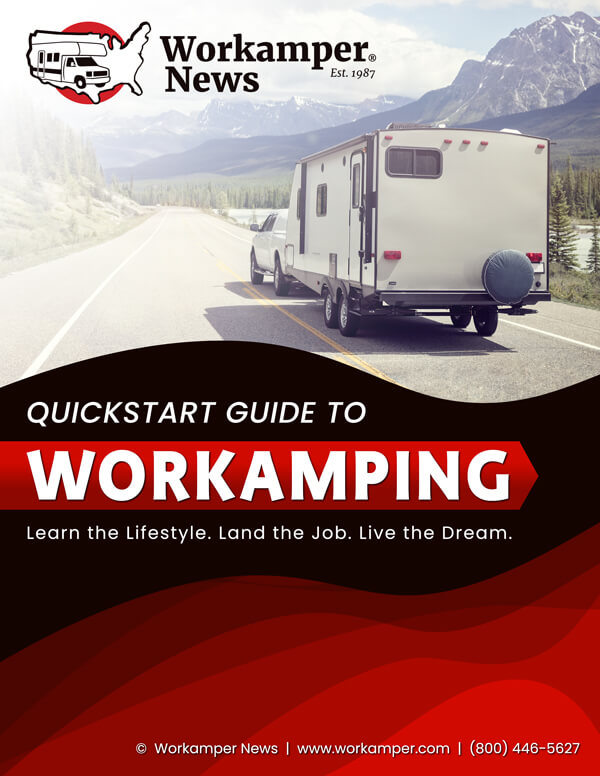Learn from our “Unbeetable Experience!”
The Sugar Beet Harvest is one of those Workamping gigs that everyone has heard about. It is detailed in many blogs and magazines, not to mention talked about among RVers. When we were first planning to become fulltime RVers, this was one of many job ideas that kept coming up. We signed up for our first harvest five years ago, and we returned for a second.

The Sugar Beet Harvest is a popular Workamping job because it pays well, your site is a part of the package deal, and the gig doesn’t last long. We made about $6,000 together our first year and pulled in a little over $8,000 the following year. That is quite a bit of money for a few weeks of work. You can probably see why this job is so popular.
There is a price to pay for the good compensation. If you are working outside at a piling station, the temperatures can get down right bone-chilling and the hours are long. For us, the pros have outweighed the cons.
In an effort to help those entering the sugar beet world for the first time, we have come up with a list of ten tips to help you through the season. Although there are a number of positions that involve working inside and outdoors, these tips mainly pertain to those assigned outside at the piling sites.
1 – Bring layers
The Sugar Beet Harvest takes place in Minnesota, North Dakota, and Montana. These areas are prone to low temperatures and strong winds throughout the season. Although this is not consistent every year. The best way to deal with the changing and unpredictable weather is to layer up. This way you can add and remove layers to regulate your body temperature.
It is a good idea to start with a base layer that wicks moisture away from your body. Many synthetic fibers such as polyester and polypropylene are good at wicking any sweat and moisture away from your body. The second and third layers are your warming section, i.e., comfy pants, sweater, and coat. The final layer should be a windbreaker and waterproof layer such as a ski jacket and ski pants. Last year I purchased a pair of waterproof, insulated work overalls and found those to be the best solution for the outer layer of my bottom half. They were pricey but well worth the cost.
Of course you don’t have to break the bank with this attire. All of these items can be purchased at a thrift store. Be sure to pick up some gloves and a warm hat while you are at it. Consider wearing a ski mask and using hand warmers for additional warmth.
2 – Get comfortable work boots
Find a comfortable pair of work boots that are waterproof. With rain comes mud, so it’s important to keep your feet warm and dry. For the most part, you will be standing on a concrete runway for 12 hours a day, excluding breaks. Everyone finds places and times to have a seat for a bit when the flow of trucks slows down, but this doesn’t happen often. The farmers want to get their beets from the ground to the pile as soon as possible so they don’t waste time unless they are nearing the end of their yield or equipment breaks.
3 – Get any mail and medications you will need for the month
One of the unfortunate things about the harvest is its unpredictability. On average, the harvest lasts 14 days. Our first season lasted a little less than two weeks. Our second time around stretched into the third week.
It all depends on the weather. If the weather is perfect, meaning adequate temperatures for harvesting and clear skies, the season will be short, less than two weeks. If the weather warms up or rain is relentless, the harvest will drag on.
For this reason, we play it safe and make it a point to stock up on needed supplies like medication and schedule to receive our mail upon arrival or a few days after arriving. It is possible to have mail forwarded to your campground.
4 – Bring snacks
Besides packing a hardy lunch, make snacks a priority, too. Working out in the cold for long periods of time is exhausting. There is no reason to be tired, cold, and hangry. Fortunately, our car was always in walking distance from our assigned piler, so we could easily retrieve any snack items.
Every day we’d pack an ice chest with various sodas and snacks and fill a thermos with hot coffee or tea. We always looked forward to our breaks and enjoying these little goodies.

5 – Don’t plan on doing much besides the harvest
Many times we take Workamping jobs so that we can explore the area. If you plan on having a lot of free time exploring the region, you may be disappointed. As mentioned, work days are 12 hours long with much of that time spent on your feet. By about the third or fourth work day, an entire day spent with your feet propped up in bed will sound like a dream vacation.
That isn’t to say days off during the harvest are unlikely. If the weather becomes too warm or the ground is too saturated and muddy, chances are your station and surrounding stations will shut down for the day and you will get a day off. If you are lucky enough to have this happen for a few days, you may find yourself with a little free time on your hands.
We had several days off during harvest our first year and only two days off in three weeks the following year. That being said, if exploring certain areas of the Upper Midwest is on your bucket list, use the time before and after the gig.
6 – Be flexible and take advantage of time off
The decision to shut a piling station down is usually due to weather and therefore isn’t made well in advance. Sometimes it’s made hours before your shift or even after you have already arrived for work. This can be a little annoying, especially if you show up to work only to be told to go home more than once.
Always keep in mind that the harvest isn’t over until the beets get harvested. For the most part, being shut down for a day will extend the harvest for a day, so those hours will eventually be worked. You will do yourself a favor and avoid stress by staying flexible. We looked at this early release as time to do laundry and gather groceries.
7 – Be open to learning other tasks
It could land you a better position in the future.
Directing trucks and collecting samples is not the only job available at a piling station. Someone has to run the piler, weigh the trucks, and use a skidsteer to clean up dirt that inevitably piles up at each site. All of the people who do these jobs want breaks every now and again, just like you do. That relief help needs to be trained.
My wife was cross-trained for the scale house our first year and ended up being assigned to the position our second year. I was trained as a backup piler operator my second year and ended up being the pile operator for a full day when the main operator was sick. I got paid extra that day.
If you don’t mind doing a variety of things, then jump on any learning opportunity you get. It is possible you could end up with a warmer, more comfortable position and depending on what job you move to, it may even pay more.

8 – Prepare for loud noises and dirt
The piling machine is loud. The trucks are loud. Many times we would continue to hear trucks rumbling by or machines whirring long after we left the worksite. Take care of your ears and make it a point to wear the supplied ear plugs if you feel the need.
Also, the piling stations are dirty, dusty and sometimes muddy. Wear clothing that you don’t mind getting ruined. We stocked our car with extra clothing including hats, socks, and gloves in case they got wet. We also kept a cardboard box in the back seat to store our dirty boots and safety gear. We always changed into a pair of comfy shoes to wear going to and from work. This helped keep some of the mud out of our car and our rig.
9 – Make friends
Each piling location has a different group of people. They are a combination of RVers as well as locals. All of you will be spending 12 hours a day, 7 days a week with each other. Part of what we enjoyed about the Sugar Beet Harvest was getting to know our coworkers. Don’t be afraid to strike up a conversation with the people standing in the cold with you; those moments could end up being the highlight of the job.
10 – Safety comes first
Safety is the number one priority with employees. Orientation and training sessions are held the first few days after arriving at your campground site. These sessions go over equipment functions, daily routines at the piling station, safety gear, and specific job duties.
There are representatives that visit each site making sure safety procedures are being followed. Hard hats, safety glasses, and a reflective vest are provided for all employees on site. They must be worn at all times at work.
The Sugar Beet Harvest has been coined the Unbeetable Experience. It definitely stands apart from our other Workamping jobs. Though we can’t say it is the easiest job we’ve ever done, we can say we will be returning to it from time to time. At this point, we would usually wish you happy trails, but for those of you about to pile sugar beets for the first time, we wish you happy harvesting.



Leave a Reply